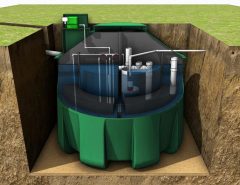Whether it’s a strange, musty smell that’s been persisting in your basement, or you’ve noticed that small puddles of water seem to collect along the corners where your basement wall meets the floor, chances are your basement needs proper waterproofing to prevent further problems. There are several reasons as to why your basement may be experiencing the disruption of invasive moisture and groundwater intrusion, but fortunately, there are also a variety of solutions to help you combat the presence of moisture in your basement space. What’s more, by fixing your wet basement problem, you’ll also improve the air quality of your home and prevent serious structural problems from arising later.
What Can Create a Wet Basement
There are various ways that excess moisture can end up in your basement and cause problems. To determine what solutions are required, you’ll need to first determine the problem sources. Wet basements can be caused by both interior as well as exterior sources, so it is important to inspect both your basement as well as the outside area around your home. Let’s have a look at some of the common causes that can lead to a wet basement…
- Leaky plumbing
- Clogged drains
- Sinking foundation
- Foundation cracks along the basement wall or basement floor
- Condensation caused by humidity
- Improperly installed basement windows
- Leaking or clogged rain gutters
- Downspout ends too close to the house foundation
- Poor grading in the land surrounding the house
- Previous waterproofing measures have failed such as clogged drainage channels or a failed sump pump
These are all possible scenarios that can arise from homeownership. But they all have a solution that can solve them and return your home to a comfortable and dry environment! Waterproofing your basement is one of the key measures to controlling how moisture interacts with your home. But there are other measures that can aid the success of your basement waterproofing. Every step taken will further protect your foundation from groundwater intrusion and damage caused by hydrostatic pressure.
Reducing Moisture Outside Your Foundation
What you do with the space outside your foundation is just as important as what you do inside your basement. Since intrusive moisture comes from the outside, the measures you take to control that moisture will impact how much your basement waterproofing will have to tackle. Here are some things you can do to take better control of the moisture outside your home…
- Maintain and clean your rain gutters and downspouts of leaves and debris
- Extend your downspout so that any rain flows out further away from your home foundation
- Improve the grading of the land surrounding your home so that it slopes away
- If you have external waterproofing measures in place, be sure to maintain them
- If you have basement window wells and window well covers, be sure to inspect them and make sure the window wells are secured against snow and water buildup
These measures can help lessen the amount of water that ends up sitting against your foundation, relieving both the amount of hydrostatic pressure there may be and reducing the chances of water seeping through your foundation. Of course, for the groundwater that does reach your foundation, you’ll want to have proper interior basement waterproofing to make sure that water goes where it belongs: outside!
Waterproofing Inside Your Basement
For interior basement waterproofing, there are several necessary components for a comprehensive waterproofing system. Along with the exterior measures, your basement waterproofing system will move any water that gets closer to your basement out and away from your home, keeping the water outside where it belongs. Let’s take a look at what makes up a waterproofing solution for basements…
- Drainage channels
- Moisture vapor barrier
- Sump pump
- Sump pit
- Dehumidifier
These components can help you manage the moisture that gets close to your basement interior. By guiding the incoming moisture via the drainage channels to a sump pit and expelling it through a discharge pipe to the outside, your basement can remain free from invasive moisture while also relieving your foundation of that hydrostatic pressure build up. This keeps your basement dry and protects the integrity of your concrete foundation. A dehumidifier can be used in conjunction with your basement waterproofing system to further maintain the moisture levels in your basement’s air—this is especially useful if you live in an area that is high in humidity.
Getting a Professional Basement Waterproofing Specialist
Some of these steps to control moisture in and around your home can be done easily by yourself, such as cleaning and maintaining your rain gutters. But for measures such as an interior basement waterproofing system, it’s best to let an experienced professional do the job to ensure that it works optimally. From high-quality drainage channels to powerful sump pumps with battery backup, ’58 Foundations offers basement waterproofing solutions that are radon-mitigation-ready and provide long-lasting effectiveness!




